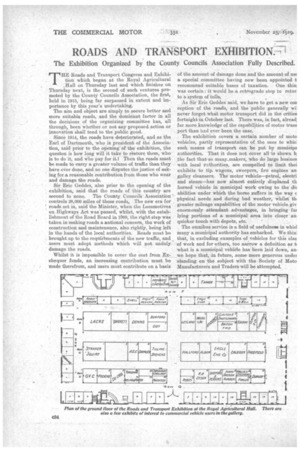ROADS AND TRANSPORT EXHIBITION:- ,
Page 26

If you've noticed an error in this article please click here to report it so we can fix it.
The Exhibition Organized by the County Councils Association Fully Described.
THE Roads and Transport Congress and Exhibition which began at the Royal Agricultural flail on Thursday last and which finishes on Thursday next, is the second of such ventures promoted by the County Councils Association, the first, held in 1915, being far surpassed in extent and importance by this year's undertaking. The aim and object are simply to secure better and more suitable roads, and the dominant factor in all the decisions a the organizing committee has, all through, been whether or not any proposed action or innovation shall tend to the public good.
Since 1914, the roads have deteriorated, and as the Earl of Dartmouth, who is president of the Association, said prior to the opening of the exhibition, the queston is how long will it take to restore them, who is to do it, and who pay for it.? Then the roads must be made to carry a greater volume of traffic than they have ever done, and no one disputes the justice of asking for a reasonable contribution from those who wear and damage the roads.
Sir Eric Geddes, also prior to the opening of the exhibition, Said . that the roads of this country are second to none. The County Council s Association controls 28,000 miles of those roads, The new era for roads set in, said the Minister, when the Locomotives on Highways Act was passed, whilst, with the establishment of the Road Board in 1909, the right step was taken in making roads a national concern, the work of construction and maintenance, also rightly, being left in the hands of the looal authorities. Roads must be brought up to the requirements of the new tralRe, and users must adopt methods which will not unduly damage the roads.
Whilst it is impossible to cover the cost from Exchequer funds, an increasing contribution must be made therefrom, and users must contribute on a basis of the amount of damage done and the amount of USE a special committee having now been appointed t recommend suitable bases of taxation. One thin, was certain: it would be a retrograde step to retur to a system of tolls, As Sir Eric Geddes said, we have to get a new can ception of the roads, and The public generally wil never forget what motor transport did in the e/itica fortnight in October last. There was, in fact, ahead; far more knowledge of the capabilities of motor trans port than had ever been the case.
The exhibition covers a certain number of moth vehicles, partly representative of the uses to whit] such means of transport can be put by munieipa authorities. That it does not cover all is shown b, the fact that so inany_niakers, who do large busines with local z.%irthorities, are compelled to limit thei exhibits to tipwagons, sweepers, fire engines an gulley cleansers. The motor vehicle—petrol, eleetri and steam—has now almost entirely displaced th horsed vehicle in municipal work owing to the dis abilities under which the home suffers in the way c physical needs and during bad weather, whilst thi greater mileage capabilities of the motor vehicle giv. enormously attendant advantages, in bringing far lying portions of a municipal area into closer am quicker touch with depots, etc.
The omnibus service is a -field of usefulness in whiel many a municipal authority has embarked. We thin] that, in excluding examples of vehicles for this chts of work and for others, too narrow a definition as t. what is a municipal vehicle has been laid down, ani we hope that, in future, some more generous under standing on the subject with the Society of Moto Manufacturers and Traders will be attempted.








































